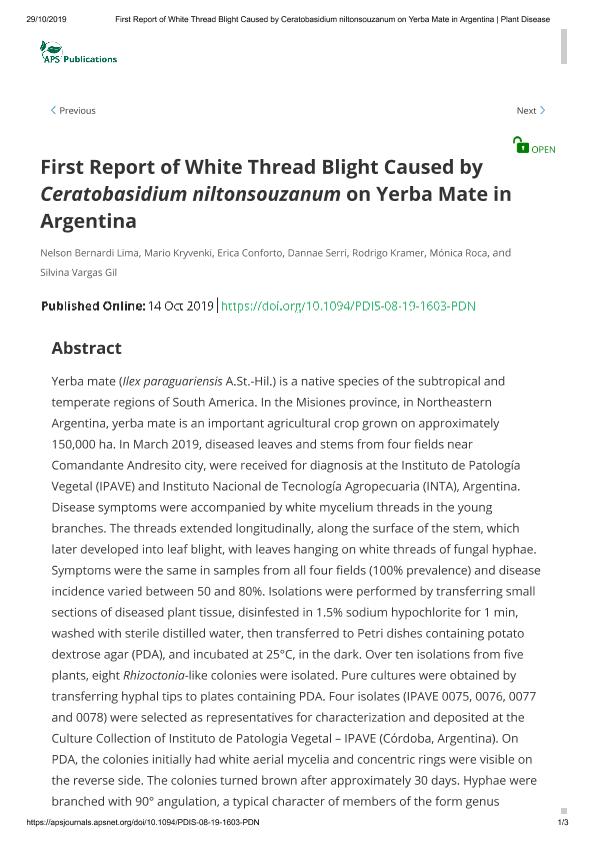Artículo
First report of white thread blight caused by ceratobasidium niltonsouzanum on yerba mate in Argentina
Bernardi Lima, Nelson ; Kryvenki, Mario Angel; Conforto, Erica Cinthia; Serri, Dannae; Kramer, Rodrigo; Roca, Monica Esther María; Vargas Gil, Silvina
; Kryvenki, Mario Angel; Conforto, Erica Cinthia; Serri, Dannae; Kramer, Rodrigo; Roca, Monica Esther María; Vargas Gil, Silvina
 ; Kryvenki, Mario Angel; Conforto, Erica Cinthia; Serri, Dannae; Kramer, Rodrigo; Roca, Monica Esther María; Vargas Gil, Silvina
; Kryvenki, Mario Angel; Conforto, Erica Cinthia; Serri, Dannae; Kramer, Rodrigo; Roca, Monica Esther María; Vargas Gil, Silvina
Fecha de publicación:
10/2019
Editorial:
American Phytopathological Society
Revista:
Plant Disease
ISSN:
0191-2917
e-ISSN:
1943-7692
Idioma:
Inglés
Tipo de recurso:
Artículo publicado
Clasificación temática:
Resumen
Yerba mate (Ilex paraguariensis A.St.-Hil.) is a native species of the subtropical and temperate regions of South America. In the Misiones province, in Northeastern Argentina, yerba mate is an important agricultural crop grown on approximately 150,000 ha. In March 2019, diseased leaves and stems from four fields near Comandante Andresito city, were received for diagnosis at the Instituto de Patología Vegetal (IPAVE) and Instituto Nacional de Tecnología Agropecuaria (INTA), Argentina. Disease symptoms were accompanied by white mycelium threads in the young branches. The threads extended longitudinally, along the surface of the stem, which later developed into leaf blight, with leaves hanging on white threads of fungal hyphae. Symptoms were the same in samples from all four fields (100% prevalence) and disease incidence varied between 50 and 80%. Isolations were performed by transferring small sections of diseased plant tissue, disinfested in 1.5% sodium hypochlorite for 1 min, washed with sterile distilled water, then transferred to Petri dishes containing potato dextrose agar (PDA), and incubated at 25°C, in the dark. Over ten isolations from five plants, eight Rhizoctonia-like colonies were isolated. Pure cultures were obtained by transferring hyphal tips to plates containing PDA. Four isolates (IPAVE 0075, 0076, 0077 and 0078) were selected as representatives for characterization and deposited at the Culture Collection of Instituto de Patologia Vegetal ? IPAVE (Córdoba, Argentina). On PDA, the colonies initially had white aerial mycelia and concentric rings were visible on the reverse side. The colonies turned brown after approximately 30 days. Hyphae were branched with 90° angulation, a typical character of members of the form genus Rhizoctonia. For molecular identification, the internal transcribed spacer (ITS) region was amplified by PCR (White et al. 1990), and sequenced. Phylogenetic analyses using Bayesian inference grouped the isolates from yerba mate with the type species of Ceratobasidium niltonsouzanum (Melo et al. 2018) with high posterior probability (0.98). Pathogenicity testing was conducted using toothpicks colonized with the pathogen (Souza et al. 2009). Inoculum was produced on PDA medium by allowing the isolates to colonize sterilized toothpicks placed on PDA, and incubating for 7 days at 25°C, under a 12h photoperiod. Twenty four-month old yerba mate plants were inoculated by inserting the colonized toothpicks into the base of the leaf petiole. Plants were kept in the greenhouse at 25°C, under high humidity, for 30 days and observed daily (Souza et al. 2009). Four control plants were mock-inoculated using only sterilized toothpicks. White thread blight symptoms were observed on all inoculated plants after 20 days, whereas control plants remained symptomless. C. niltonsouzanum was re-isolated from symptomatic tissue (leaves and petiole) of the inoculated plants, with a frequency of 100%, thereby validating Koch?s postulates. The experiment was performed twice. C. niltonsouzanum has been reported as a pathogen on numerous crops including Coffea arabica, Camellia sinensis, Azadirachta indica and Eugenia uniflora in Brazil (Melo et al 2018). This work improves knowledge surrounding the etiology of the disease associated with yerba mate in Argentina, which is essential information for the identification of appropriate management practices. To our knowledge, this is the first report of C. niltonsouzanum causing white thread blight of yerba mate in Argentina and worldwide.
Palabras clave:
ILEX PARAGUARIENSIS
,
WHITE THREAD BLIGHT
,
RHIZOCTONIA-LIKE FUNGI
Archivos asociados
Licencia
Identificadores
Colecciones
Articulos (UFYMA)
Articulos de UNIDAD DE FITOPATOLOGIA Y MODELIZACION AGRICOLA
Articulos de UNIDAD DE FITOPATOLOGIA Y MODELIZACION AGRICOLA
Citación
Bernardi Lima, Nelson; Kryvenki, Mario Angel; Conforto, Erica Cinthia; Serri, Dannae; Kramer, Rodrigo; et al.; First report of white thread blight caused by ceratobasidium niltonsouzanum on yerba mate in Argentina; American Phytopathological Society; Plant Disease; 104; 2; 10-2019; 1-3
Compartir
Altmétricas



